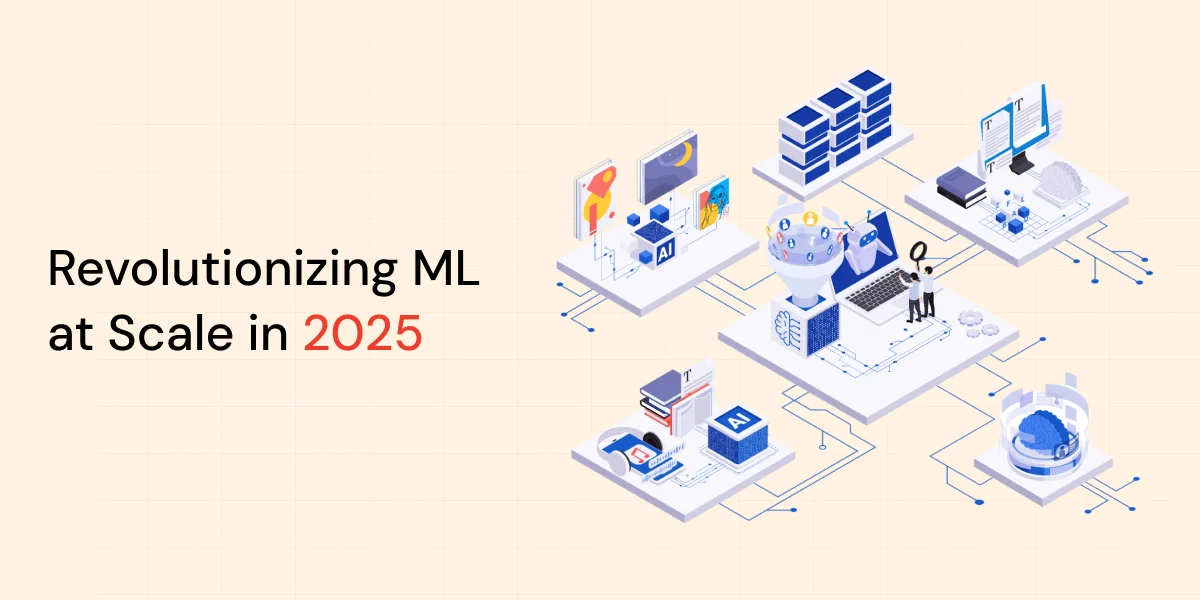In today’s data-driven landscape, organizations are generating unprecedented volumes of data that require sophisticated machine learning solutions capable of processing information at massive scale. Apache Spark ML and Databricks ML have emerged as the leading platforms for distributed machine learning, offering unprecedented capabilities for data scientists and engineers working with big data. This comprehensive guide explores how these powerful frameworks are transforming machine learning workflows, from data preparation to model deployment and monitoring.
Apache Spark ML (MLlib) represents a paradigm shift in how organizations approach machine learning at scale. As the machine learning component of the Apache Spark unified analytics engine, Spark ML provides distributed algorithms and utilities designed to handle massive datasets that traditional single-machine libraries cannot process efficiently.
- What is Apache Spark ML?
- Key characteristics of Spark ML
- Evolution from RDD-based to DataFrame-based API
- Understanding Databricks ML Platform
- Core Components of Databricks ML
- Databricks vs Traditional ML Platforms
- Core Components and Architecture
- Memory Management and Optimization
- Spark ML vs Traditional ML Libraries
- Benchmark Results
- Algorithm Availability Comparison
- Getting Started with Spark ML
- Advanced Features and Capabilities
- Best Practices and Optimization
- Real-World Use Cases
- Troubleshooting Common Issues
- Future of Spark ML and Databricks
- Integration with Modern ML Ecosystem
- Conclusion
What is Apache Spark ML?
Apache Spark ML is Spark’s scalable machine learning library that includes implementations of common learning algorithms, feature transformation utilities, ML Pipeline functionality, and utilities for linear algebra, statistics, and data handling. The library is built on top of Spark DataFrames and provides a high-level API that leverages Spark’s distributed computing capabilities.
Key characteristics of Spark ML
- Distributed Processing: Algorithms automatically distribute computation across cluster nodes
- In-Memory Computing: Leverages Spark’s in-memory processing for iterative ML algorithms
- Unified API: Consistent programming interface across different ML algorithms
- Pipeline Support: End-to-end ML workflow management
- Multi-Language Support: APIs available in Scala, Java, Python, and R
Evolution from RDD-based to DataFrame-based API
Originally, Spark MLlib was built on Resilient Distributed Datasets (RDDs). However, starting with Spark 2.0, the primary ML API transitioned to DataFrame-based operations under the spark.ml package. This transition brought several advantages:
- Better Performance: DataFrames leverage Catalyst optimizer and Tungsten execution engine
- Schema Inference: Automatic data type detection and validation
- SQL Integration: Seamless integration with Spark SQL operations
- Cross-Language Consistency: Uniform behavior across Python, Scala, Java, and R
Understanding Databricks ML Platform
Databricks ML extends Apache Spark’s capabilities by providing a comprehensive, cloud-native platform for the entire machine learning lifecycle. Built on top of Apache Spark, Databricks ML integrates additional tools and services that streamline ML development, deployment, and management.
Core Components of Databricks ML
Databricks Runtime for Machine Learning
Databricks Runtime ML is a pre-configured environment that includes:
- Latest versions of popular ML libraries (scikit-learn, TensorFlow, PyTorch, XGBoost)
- Optimized Spark ML algorithms
- GPU support for deep learning workloads
- Built-in security and compliance features
MLflow Integration
Databricks provides managed MLflow for:
- Experiment Tracking: Automatically log parameters, metrics, and artifacts
- Model Registry: Centralized model versioning and lifecycle management
- Model Serving: One-click deployment to production endpoints
- Model Monitoring: Track model performance and data drift
AutoML Capabilities
Databricks AutoML automates the machine learning process by:
- Automatically selecting appropriate algorithms
- Performing feature engineering
- Tuning hyperparameters
- Generating production-ready code
- Providing model explanations
Feature Store
The Databricks Feature Store provides:
- Centralized feature repository
- Feature lineage and governance
- Automated feature serving
- Feature sharing across teams
- Point-in-time correctness for feature lookup
Databricks vs Traditional ML Platforms
| Feature | Databricks ML | Traditional Platforms |
| Scalability | Unlimited horizontal scaling | Limited by single machine resources |
| Data Integration | Native big data connectivity | Requires separate ETL processes |
| Collaboration | Built-in notebook sharing | Limited collaboration features |
| MLOps | Integrated ML lifecycle management | Requires multiple tools |
| Performance | Distributed computing optimization | Single-threaded processing |
Core Components and Architecture
Spark ML Architecture Overview
The Spark ML ecosystem consists of several interconnected components working together to provide comprehensive machine learning capabilities:
DataFrame-based Data Structures
- DataFrame: Primary data structure for ML operations
- Features Column: Vector column containing input features
- Label Column: Target variable for supervised learning
- Prediction Column: Model output column
ML Pipeline Components
Transformers are algorithms that transform DataFrames. Examples include:
- Feature extractors (e.g., TF-IDF, Word2Vec)
- Feature selectors (e.g., ChiSqSelector)
- Feature scalers (e.g., StandardScaler, MinMaxScaler)
- Trained models (e.g., LinearRegressionModel)
Estimators are algorithms that fit on DataFrames to produce Transformers:
- Learning algorithms (e.g., LinearRegression, RandomForest)
- Feature transformation estimators (e.g., StringIndexer)
Pipeline combines multiple Estimators and Transformers into a single workflow:
Parameter Specification
Spark ML uses a uniform API for specifying algorithm parameters:
- Param: A named parameter
- ParamMap: Set of (parameter, value) pairs
- ParamGridBuilder: Utility for building parameter grids for model selection
Memory Management and Optimization
Spark ML leverages several optimization techniques:
Catalyst Optimizer
- Predicate Pushdown: Filters applied early in query execution
- Column Pruning: Only required columns loaded into memory
- Code Generation: Runtime code generation for improved performance
Tungsten Execution Engine
- Memory Management: Off-heap memory management
- Cache-Aware Computation: CPU cache optimization
- Whole-Stage Code Generation: Eliminates virtual function calls
Spark ML vs Traditional ML Libraries
Performance Comparison
The choice between Spark ML and traditional libraries like scikit-learn depends on data size, computational requirements, and infrastructure constraints.
When to Use Spark ML
Data Volume Scenarios:
- Datasets larger than single machine memory (>100GB)
- Streaming data processing requirements
- Need for distributed feature engineering
- Complex ETL pipelines combined with ML
Performance Benefits:
When to Use Traditional Libraries
Suitable Scenarios:
- Small to medium datasets (<10GB)
- Rapid prototyping and experimentation
- Advanced algorithm requirements not available in Spark ML
- Single-machine deployment constraints
Benchmark Results
Based on recent performance studies:
| Dataset Size | Spark ML Training Time | Scikit-learn Training Time | Speedup |
| 1GB | 2.5 minutes | 1.8 minutes | 0.7x (overhead) |
| 10GB | 8.2 minutes | 45 minutes | 5.5x |
| 100GB | 25 minutes | Memory Error | ∞ |
Algorithm Availability Comparison
| Algorithm Category | Spark ML | Scikit-learn | XGBoost |
| Linear Models | ✓ | ✓✓✓ | ✓ |
| Tree-based | ✓✓ | ✓✓✓ | ✓✓✓ |
| Clustering | ✓✓ | ✓✓✓ | ✗ |
| Deep Learning | Limited | ✗ | ✗ |
| Feature Engineering | ✓✓✓ | ✓✓ | ✗ |
Getting Started with Spark ML
Environment Setup
Local Development Setup
Databricks Cluster Configuration
Basic Linear Regression Example
Building ML Pipelines
Feature Engineering Best Practices
Advanced Features and Capabilities
Hyperparameter Tuning
Spark ML provides built-in support for hyperparameter optimization through CrossValidator and TrainValidationSplit:
Streaming ML with Structured Streaming
Custom Transformers and Estimators
Best Practices and Optimization
Performance Optimization Strategies
Memory Management
Data Caching Strategies
Partition Optimization
MLOps Best Practices
Model Versioning with MLflow
Feature Store Integration
Data Quality and Validation
Real-World Use Cases
Customer Churn Prediction
Fraud Detection
Troubleshooting Common Issues
Memory and Performance Issues
OutOfMemoryError Solutions
Slow Training Performance
Data Type and Schema Issues
Model Convergence Issues
Future of Spark ML and Databricks
Emerging Trends and Technologies
GPU Acceleration
- RAPIDS Integration: Accelerated data processing with GPU computing
- Distributed GPU Training: Multi-GPU model training across clusters
- Auto-scaling GPU Clusters: Dynamic resource allocation for ML workloads
AI and AutoML Advancements
- Neural Architecture Search: Automated deep learning model design
- AutoML Pipelines: End-to-end automated machine learning workflows
- Explainable AI: Built-in model interpretability and explanation
Real-time ML Capabilities
- Stream Processing: Enhanced real-time feature engineering
- Online Learning: Continuous model updates with streaming data
- Edge Deployment: Model deployment to edge computing devices
Integration with Modern ML Ecosystem
MLOps Platform Evolution
Conclusion
Apache Spark ML and Databricks ML represent the cutting edge of scalable machine learning, offering unprecedented capabilities for organizations working with large-scale data. As the volume and complexity of data continue to grow, these platforms provide essential tools for building, deploying, and maintaining machine learning systems at enterprise scale.
The journey from traditional machine learning to distributed ML platforms requires careful consideration of data size, computational requirements, and organizational capabilities. However, for organizations ready to embrace the full potential of their data, Spark ML and Databricks ML offer a path to advanced analytics and AI-driven insights that were previously impossible to achieve.
By following the best practices, optimization techniques, and implementation strategies outlined in this guide, data scientists and engineers can successfully leverage these powerful platforms to drive innovation and create competitive advantages in today’s data-driven business environment.
This comprehensive guide to Apache Spark ML and Databricks ML provides the foundation for understanding and implementing scalable machine learning solutions. As these technologies continue to evolve, staying updated with the latest features and best practices will be crucial for maximizing their potential in your organization.
Frequently Asked Questions
MLlib (spark.mllib): The original RDD-based API, now in maintenance mode
Spark ML (spark.ml): The newer DataFrame-based API, actively developed and recommended for new projects
The DataFrame-based API offers better performance, easier integration with Spark SQL, and more intuitive pipeline construction.
Small datasets (<1GB): Scikit-learn typically faster due to optimized single-machine algorithms
Large datasets (>10GB): Spark ML significantly faster due to distributed processing
Memory constraints: Spark ML handles datasets larger than RAM, scikit-learn requires data to fit in memory
Scikit-learn: Use pandas UDFs to apply scikit-learn models to Spark DataFrames
TensorFlow/PyTorch: Distribute deep learning training using libraries like Horovod
XGBoost: Native XGBoost integration available in Databricks Runtime ML
Use Pipeline for reproducibility: Combine all transformations in a single Pipeline
Cache intermediate results: Cache DataFrames after expensive transformations
Handle missing values consistently: Use consistent strategies across training and inference
Optimize data types: Use appropriate data types to minimize memory usage
Leverage built-in transformers: Use Spark ML’s built-in feature transformers for common operations
For Training Workloads:
– Memory-optimized instances (e.g., r5.xlarge)
– Higher memory-to-core ratio (8GB+ per core)
– Enable dynamic allocation for cost optimization
For Inference Workloads:
– CPU-optimized instances for fast predictions
– Lower latency storage (SSD)
– Consider spot instances for cost savings
– Structured Streaming: Process streaming data with pre-trained models
– Model Serving: Deploy models as REST APIs using MLflow
– Databricks Model Serving: Managed inference endpoints with auto-scaling
– Algorithm variety: Fewer algorithms compared to scikit-learn
– Deep learning: Limited deep learning capabilities compared to TensorFlow/PyTorch
– Single-machine optimization: Less optimized for small datasets
– Complex models: Some advanced algorithms not available
– Assess data size: Determine if distributed processing is needed
– Map algorithms: Find equivalent Spark ML algorithms
– Refactor code: Convert pandas DataFrames to Spark DataFrames
– Update pipelines: Use Spark ML Pipeline instead of scikit-learn Pipeline
– Test performance: Compare accuracy and performance metrics




